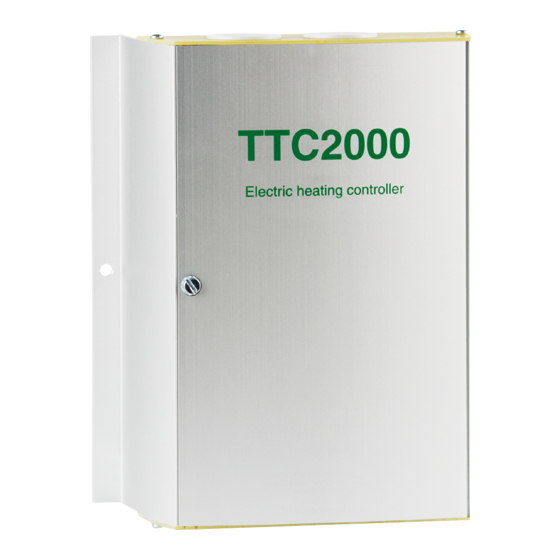Advertisement
Quick Links
TTC2000
TTC2000
207
160
IMPORTANT: Read these
instructions before installation and
!
wiring of the product.
L1
L1
L2
L2
L3
L3
in
out
in
out
in
out
Switches
Min
Max
CT
Fig 1
1 2 3 4 5 6 7 8 9
Setpoint
Fig 2
Box 116 428 22 KÅLLERED SWEDEN
Tel +46 (0)31 720 02 00 Fax +46 (0)31 720 02 50
®
Advanced Test Equipment Rentals
www.atecorp.com 800-404-ATEC (2832)
INSTRUCTIONS
Triac controller for proportional control
of electric heating
TTC2000 is a proportional controller for electric heating with automatic
voltage adaption. TTC2000 pulses the whole load On - Off. The ratio
between On-time and Off-time is varied 0 - 100% to suit the prevailing heat
demand. The current is always switched at zero phase angle to prevent
RFI.
TTC2000 is primarily intended for use with Regin TG-sensors for either
supply air control or room control with maximum and/or minimum limiting of
the supply air temperature.
TTC2000 can also be controlled by an external 0...10 V DC control signal.
TTC2000 can control both symmetrical Y-connected 3-phase heaters and
symmetrical or asymmetrical Delta-connected heaters.
TTC2000 is only intended for electric heating control. The control principle
makes it unsuitable for motor- or lighting control.
Installation
Mount TTC2000 on a wall or in a cabinet or other enclosure.
Mount TTC2000 vertically with the text right side up.
Protection class:
IP30.
Ambient temperature:
0 - 40°C
N.B. TTC2000 emits approx. 45W of heat at full output which must be
dissipated.
N.B. The front cover has no hinges and can fall out when the screw is
unscrewed.
Wiring
Supply voltage (fig 1)
Terminals L1in, L2in and L3in.
Supply voltage: 210-255 or 380-415V AC
3 phase, 50 - 60 Hz with automatic voltage adaption.
Maximum current 25A/phase.
N.B. The supply voltage to TTC2000 should be wired via an all-pole switch
with a minimum contact gap of 3mm.
N.B. TTC2000 must be earthed.
Load (fig 1)
Terminals L1out, L2out and L3out.
Resistive 3-phase heater without neutral.
Maximum load:
3300W/phase at 230V phase - phase voltage (25A).
5750W/phase at 400V phase - phase voltage (25A).
Minimum load:
530W/phase at 230V phase - phase voltage (4A).
920W/phase at 400V phase - phase voltage (4A).
The terminal block is of screwless type.
In order to open the clamping jaws, press a screwdriver into the upper,
rectangular slot. See fig 2. Insert the wire into the larger round hole and
remove the screwdriver. Check that the wire is securely clamped.
INSTRUCTIONS
Main sensor and external setpoint (figs 3-7)
Terminals 1 and 4. Low voltage. Not polarity sensitive.
N.B. Terminals 2 and 3 are internally connected and are used
to simplify wiring when using external setpoint.
N.B. Choice of internal or external setpoint is made using
switch 1.
Limiting sensor (fig 8)
Terminals 5 and 6. Low voltage. Not polarity sensitive.
When running room temperature control the supply air temperature can
be limited to a maximum and/or a minimum. The limiting sensor is placed
in the supply air duct after the heater.
Choice of function is made using switches 2 and 3. Choice of limiting
temperatures is made on potentiometers Min and Max.
N.B. As limiting sensor TG-K360 must be used.
Figures
Fig 1: Wiring of supply voltage and heater.
Fig 2: Instruction for the screwless terminal block.
Fig 3: Wiring of room sensor TG-R530 or
TG-R6xx when using internal setpoint.
Fig 4: Wiring of room sensor TG-R430 used as external setpoint and
sensor.
Fig 5: Wiring of floor or duct sensor when using internal setpoint.
Fig 6: Wiring of external separate sensor when using TG-R4xx as
external setpoint.
Fig 7: Wiring of external, separate sensor when using potentiometer
TBI-xx as external setpoint.
Fig 8: Wiring of limiting sensor.
N.B. TG-K360 must be used.
Fig 9: Wiring of external control signal
Settings
Potentiometers
Setp. Setpoint 0 - 30°C.
Min
Minimum limit for supply air temperature when running room
temperature control.
Max
Maximum limit for supply air temperature when running room
temperature control.
CT
Cycle time. 6 - 120 seconds.
Switches
1
Down = External setpoint in use.
Up = Internal setpoint in use.
2
Down = Minimum limit not active.
Up = Minimum limit active.
3
Down = Maximum limit not active.
Up = Maximum limit active.
N.B.
Minimum and maximum limiting functions may be used
separately or at the same time.
Advertisement

Summary of Contents for Regin TTC 2000
- Page 1 RFI. Terminals 5 and 6. Low voltage. Not polarity sensitive. TTC2000 is primarily intended for use with Regin TG-sensors for either When running room temperature control the supply air temperature can supply air control or room control with maximum and/or minimum limiting of be limited to a maximum and/or a minimum.
- Page 2 INSTRUCTIONS INSTRUCTIONS TTC2000 Control principle TTC2000 pulses the full load On - Off. TTC2000 adjusts the mean power output to the prevailing power demand by proportionally adjusting the ratio TG-R4xx between On-time and Off-time. The cycle time (=the sum of On-time and Off-time) is adjustable 6 - 120 seconds.

















Need help?
Do you have a question about the TTC 2000 and is the answer not in the manual?
Questions and answers